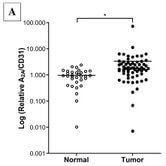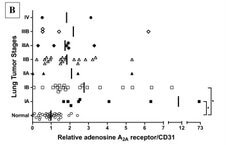Adenosine A2A Receptor: A Prognosis Marker for Lung Cancer
Tech ID: 08-11
Summary
The role of angiogenesis in tumor survival and metastasis is now well recognized. Hypoxia-inducible transcription factors HIF-1alpha and HIF-2alpha are both known to induce angiogenesis by upregulating a common set of cytokines, including VEGF, but only the activation of HIF-2alpha has been associated with poor prognosis in lung cancer. However, since HIF-2alpha is highly labile, it is a poor candidate for a biomarker.
Scientists at National Jewish Health have discovered that the receptor Adenosine A2A (ADORA2A) is expressed only in response to HIF-2alpha activation and more importantly that the expression of ADORA2A is increased in later stage lung tumors.
This receptor could therefore be used as a prognosis marker for lung cancer as well as a potential new target for an anti-angiogenic approach to treating lung cancer.
Potential Applications
A biomarker for HIF-2alpha activation and therefore for poor prognosis in lung cancer.
A target for anti-angiogenic therapy in lung cancer
Advantages of Invention
Since HIF-2alpha is too labile to be used as a marker, ADORA2A instead can be used as readout of HIF-2alpha activation and can be easily measured at the RNA level in biopsy samples.
State of Development
Our scientists have found that:
Hypoxia increases ADORA2A in vitro
HIF-2alpha and not HIF-1alpha regulates ADORA2A expression
Overexpression of ADORA2A or its activation through agonists leads to an increase in endothelial cell proliferation, migration, and branching
ADORA2A expression increases in later stage tumor samples collected from lung cancer patients
Adenosine A2A receptor expression is increased in lung tumor samples at different stages:
 (A) Human lung cancer expression panels (I and IV) containing reverse-transcribed cDNA from the different tumor stages were probed with real-time Taqman primers and probes for adenosine A2A receptor and CD31. The A2A expression data were normalized to CD31 expression. The different tumor stages were grouped together and plotted after log transformation. *, Statistical difference from the normal lung tissue using a 2-sample t test.
(A) Human lung cancer expression panels (I and IV) containing reverse-transcribed cDNA from the different tumor stages were probed with real-time Taqman primers and probes for adenosine A2A receptor and CD31. The A2A expression data were normalized to CD31 expression. The different tumor stages were grouped together and plotted after log transformation. *, Statistical difference from the normal lung tissue using a 2-sample t test.

(B) Normalized A2A expression data were plotted against the different stages of tumors. ANOVA was used to compare the groups, followed by pairwise comparisons of normal tissue versus each of the other groups using Dunnett's procedure. *, Statistically different from the normal lung tissue.

(C) CC1-CC4 show significant positive CD31 (PECAM-1; pinkish-red) immunostaining in the bronchovascular bundles (CC1-CC3) and parenchyma (CC3 and CC4) of normal (atelectatic) lung tissue obtained at surgery. Staining of venous and/or lymphatic vessel endothelium (CC1, arrow) and arterial vessel endothelium (CC2 and CC3, arrowheads) was variable but notably positive, as was the capillary endothelium (CC3 and CC4). Immunostaining for adenosine receptor A2A (brown) was largely absent from these tissues. By contrast, lung cancer specimens from both of these patients (CT1, CT2, CT3, and CT4) stained markedly positive, especially in the tumor stroma. In these regions, CD31-positive-staining cells, likely endothelial cells and/or tumor macrophages, coimmunostained positively for adenosine receptor A2A or, in some cases, A2A-positive cells were immediately adjacent to those staining positively for CD31 (Magnification: 40X).
Publications
Ahmad, A., S. Ahmad, L. Glover, S. M. Miller, J. M. Shannon, X. Guo, W. A. Franklin, J. P. Bridges, J. B. Schaack, S. P. Colgan, and C. W. White. "Adenosine A2A Receptor Is a Unique Angiogenic Target of HIF-2 in Pulmonary Endothelial Cells."Proceedings of the National Academy of Sciences 106.26 (2009): 10684-0689. PMID: 19541651.
Ahmad, Aftab, Shama Ahmad, Kenneth C. Malcolm, Stacy M. Miller, Tara Hendry-Hofer, Jerome B. Schaack, and Carl W. White. "Differential Regulation of Pulmonary Vascular Cell Growth by Hypoxia-Inducible Transcription Factor–1a and Hypoxia-Inducible Transcription Factor–2a." American Journal of Respiratory Cell and Molecular Biology. American Thoracic Society, n.d. Web. 26 Jan. 2015. PMCID:PMC3727885.
Ahmad, Aftab, Jerome B. Schaack, Carl W. White, and Shama Ahmad. "Adenosine A2A Receptor-dependent Proliferation of Pulmonary Endothelial Cells Is Mediated through Calcium Mobilization, PI3-kinase and ERK1/2 Pathways." Biochemical and Biophysical Research Communications. U.S. National Library of Medicine, n.d. Web. 26 Jan. 2015. PMCID: PMC4046330.
Patent Status
U.S. patent application #2016-0310492-A1 and #20090155796. International Patent Publication #WO2009/065044.
Inventors
Aftab Ahmad, PhD and Carl White, MD
Licensing Status
Available for licensing.
For Further Information, Contact:
Emmanuel Hilaire, PhD
Director
Technology Transfer Office
National Jewish Health
1400 Jackson Street, Room M206b
Denver, CO 80206
Voice: 303.398.1262
Fax: 303.270.2352
HilaireE@njhealth.org
